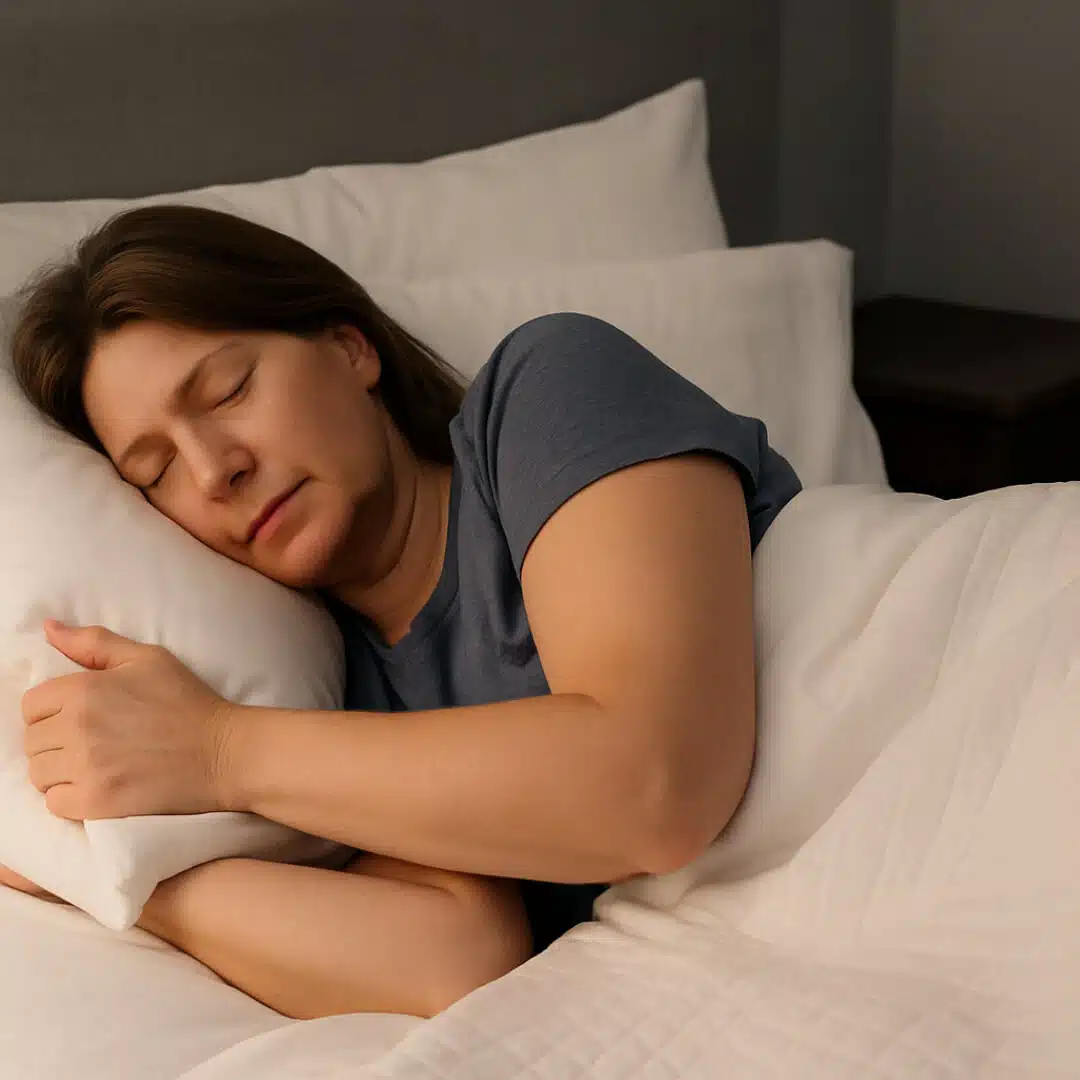May 2025
Why Your Shoulder Hurts More at Night—And What You Can Do About It
A Personal Note from Dr.Scott:

A Personal Note from Dr.Scott:
There’s something about May that feels like a fresh start.
Maybe it’s the longer days, the warmer weather, or the way everything seems to be blooming again. After a long winter (and let’s be honest, a hectic spring), May gives us all a chance to reset—physically, mentally, and emotionally.
It’s also the month we celebrate Mother’s Day, which always reminds me how important it is to slow down and appreciate the people who show up for us day in and day out. Whether it’s your mom, your partner, your sister, a friend—or maybe it’s you—this month is about honoring the strength, resilience, and love that so many women pour into others, often while putting themselves last.
So here’s a gentle nudge:
Make May the month you put yourself back on your list.
Not in a dramatic, overhaul-your-life kind of way… but in small, intentional moments. Maybe that’s going for a walk outside each morning. Booking that appointment you’ve been putting off. Or simply giving yourself permission to slow down and breathe.
Whatever it is—your future self will thank you.
Wishing you a strong, healthy, and joy-filled May. And to all the moms in our community: we see you, we appreciate you, and we’re better because of you.
To your health,
Dr. Scott Gray
Featured Article of the Month
Why Your Shoulder Hurts More at Night—And What You Can Do About It
If you’re reading this at 2 a.m. while trying to shift into a position that doesn’t send a shooting pain through your shoulder, you’re not alone. Shoulder pain that worsens at night is incredibly common—and incredibly frustrating. It disrupts your sleep, drains your energy, and can even affect your daily life by leaving you fatigued and irritable.
But why does it happen? Why does your shoulder feel worse at night than during the day? And more importantly—what can you actually do to fix it?
In this blog, we’ll explore the real reasons shoulder pain flares up at night, the most common conditions behind it, and how to get lasting relief (without injections, surgery, or endless rounds of rest).

Why Shoulder Pain Gets Worse at Night
During the day, you’re busy. You’re moving. You’re distracted. But when you lie down and everything gets quiet, your body starts speaking louder—and if you’re dealing with an underlying shoulder issue, it tends to scream.
Here’s the thing: even though your shoulder pain shows up at night, the issue didn’t start there.
It likely began during the day—due to poor posture, overuse, weakness, or even faulty movement patterns you weren’t aware of. The nighttime pain is just the symptom showing up when your body finally stops moving.
That’s why at Back in Motion, we use The Gray Method™ to uncover the true root cause of your shoulder pain. We analyze how you move, identify the dysfunction, and correct the imbalance—so it doesn’t keep showing up when you’re trying to sleep.
What’s Causing Your Shoulder Pain at Night?
If you wake up multiple times a night trying to find a comfortable position, one of these conditions might be to blame:
1. Rotator Cuff Tendinitis or Tear
Your rotator cuff is a group of muscles and tendons that hold your shoulder in place. When inflamed or torn, even small movements (or the pressure from lying down) can trigger sharp pain. Over time, it gets harder to lift your arm, sleep comfortably, or even get dressed.
It doesn’t go away on its own. The pain might ebb and flow, but without proper treatment, it often comes back stronger.
2. Shoulder Bursitis
Bursae are small, fluid-filled sacs that cushion your shoulder. When inflamed, the bursa becomes incredibly sensitive—especially to pressure. Side sleeping? Forget about it. Even the weight of your arm can feel unbearable.
When you’re still at night, fluid builds and tissues stiffen—making the pain worse.
3. Shoulder Impingement Syndrome
This happens when soft tissues (like tendons or the bursa) get pinched between bones in your shoulder. It’s common if you sleep with your arm overhead or in certain “closed” positions. You might feel a deep, dull ache or sharp pinching pain when you roll onto your side.
Impingement can limit your range of motion and lead to tears if left untreated.
4. Frozen Shoulder (Adhesive Capsulitis)
This condition is exactly what it sounds like—your shoulder becomes stiff, painful, and hard to move. It often starts gradually and is common after an injury or period of inactivity.
Lying still for too long increases inflammation, and trying to shift positions feels like someone’s twisting your joint.
5. Referred Pain from the Neck
Surprise: not all shoulder pain starts in the shoulder. A pinched nerve in your neck can radiate down into your shoulder and arm. It’s often worse when lying down due to neck positioning or pressure on the cervical spine.
Numbness, tingling, or pain shooting down your arm may be signs your neck is the real culprit.
How to Fix Nighttime Shoulder Pain (For Good)
Most people are told to “rest it” or take painkillers. But rest without the right plan can actually make things worse.
Here’s what you need instead:
1. Change Your Sleep Setup
- Sleep on your non-painful side with a pillow between your arms.
- If on your back, place a small pillow under your elbow to elevate and support your arm.
- Try a reclined position if lying flat makes things worse.
2. Apply Heat or Ice—Strategically
- Ice can reduce inflammation before bed.
- Heat can relax tight tissues and ease stiffness.
3. Stay Gently Active During the Day
- Movement matters. Daily light stretching and mobility work can keep your shoulder from stiffening up overnight.
- Try pendulum swings, scapular retractions, or wall slides.
4. See a Specialist (Early)
If your shoulder pain lasts more than 2 weeks or is affecting your sleep, it’s time to get expert help.
At Back in Motion Physical Therapy & Performance, we don’t just mask the pain—we fix the cause.
We take you through our proven evaluation process, identify what’s really behind your pain, and build a plan that helps you:
- Sleep better
- Move pain-free
- Avoid injections, surgery, and long-term damage
Learn more about our shoulder pain treatment in Fort Myers & Cape Coral
You Deserve a Good Night’s Sleep
Shoulder pain doesn’t have to rule your nights (or your days). Whether it’s tendinitis, bursitis, or a frozen shoulder, the longer you wait, the worse it can get.
Here’s something most people don’t realize: nighttime pain is just the final straw. The real issue often starts during the day—from poor posture, repeated strain, or faulty movement patterns that build up quietly until your body finally forces you to listen.
That’s where The Gray Method™ comes in. Our approach looks deeper to find out why your shoulder is irritated in the first place, not just how to mask the pain. By correcting these root causes, we can stop your pain from flaring up at night—and help you sleep, move, and live better.
Don’t ignore it. Don’t push through it. And don’t settle for another sleepless night.
Let’s fix what’s actually causing your pain—so you can rest easy, move freely, and get back to living.
Visit our Fort Myers Physical Therapy clinic if you’re in the area, or contact us today to request an appointment.
Staff Spotlight
Staff Spotlight – Meet Oliver Gray

Oliver Gray, the spirited standard poodle, sports a striking red coat that turns heads wherever he goes, its vibrant hue gleaming like a sunset. Often mistaken for a golden doodle due to his luxurious, curly locks, Oliver is a proud, full-blown poodle, embodying the breed’s elegance and intelligence with every prance. His fiery coat only amplifies his larger-than-life personality, making him the ultimate showstopper. Devoted to his mom and dad, he showers them with affection, his soulful eyes lighting up at their every word. Long walks are his playground, where he struts with flair, chasing his beloved ball with boundless enthusiasm. Swimming is his true passion, as he dives into pools or lakes, his red coat shimmering in the water like a crimson wave.
At mealtime, Oliver’s heart belongs to eggs with cheese, which he devours with a gusto that rivals a gourmet critic. At Back in Motion, he’s the star greeter, charming patients with his wagging tail and magnetic presence, thriving as the center of attention. Though his red coat may spark doodle confusion, Oliver Gray is unmistakably a pure poodle, stealing hearts with his vibrant spirit and undeniable poodle pride!
Oliver’s Healthy Recipe

Oliver’s Corner Recipe: Spring Berry Power Bowl

A refreshing, protein-packed bowl that supports joint health, boosts energy, and keeps inflammation in check—perfect for breakfast or a mid-day recharge.
Ingredients:
- 1 cup plain Greek yogurt (or dairy-free alternative)
- ½ cup mixed fresh berries (blueberries, strawberries, raspberries)
- ¼ cup rolled oats (soaked in water or almond milk for 5–10 mins if raw)
- 1 tbsp chia seeds
- 1 tbsp chopped walnuts (or almonds for crunch & omega-3s)
- 1 tsp ground flaxseed
- 1 tsp honey or maple syrup (optional, for sweetness)
- Dash of cinnamon (anti-inflammatory)
Ingredients
Fitness Corner
Fitness Corner → A Coach’s Confession
Hi! It’s Coach Katy.
“I skipped my warm-up last week… and paid for it.”
Yep — guilty.
It was early, I was in a rush, and I told myself, “I’ll just ease into it.”
Spoiler: I didn’t.
I jumped straight into some heavier squats, felt stiff, and spent the rest of the day wondering why my hip felt like I lost a fight with a staircase.
Here’s the deal: even coaches cut corners sometimes — and our bodies remind us real fast why those “little things” matter.
So if you ever think:
- “It’s fine, I’ll skip mobility today…”
- “I’ll stretch later…”
- “I don’t need to activate my glutes…”
Just remember: Coach did that. Coach regretted that.
Lesson:
Warm-ups aren’t optional. They’re injury prevention insurance.
Take 5 minutes, move intentionally, and your body will thank you.

Try This at Home
The Marching Core Test
Want to know if your core is actually doing its job — or just along for the ride?
Here’s a simple test we use in the clinic to spot compensation and weak core control in seconds.
Marching Core Test:
- Lie on your back with your knees bent and feet flat on the floor.
- Place one hand under your lower back — you should feel a small space.
- Engage your core (gently flatten that space) and slowly lift one foot a few inches off the ground — like a slow marching motion.
- Lower the foot and switch sides.
What to watch for:
- Does your back arch or flatten drastically?
- Does your belly push out or grip tightly?
- Do you feel your hip flexors or lower back working more than your abs?
If yes — your core may not be stabilizing properly. And that could be contributing to your back, hip, or knee pain.

Fitness Client Of The Month
Fitness Client of the Month —Kelly Edison
Kelly Edison never loved working out— But as she approached perimenopause, she had a moment of realization: it was now or never.
She knew her body was changing, and if she didn’t take action, things would only get harder.
That’s when she found Back In Motion.
With the right guidance, accountability, and a plan built for her body, Kelly became the leanest and strongest she’s ever been.
Now, she feels confident, empowered, and in control of her health—without dreading her workouts.

Client Case Study of the Month
Client Case Study of the Month – Aurelia Bell
Aurelia is in her 70s, active, motivated, and not one to complain.
But for over a few months, she struggled with nagging foot pain — specifically over the ball of her right foot, near her 3rd MTP joint.
Walking, standing, and even light exercise became uncomfortable. She tried different shoes, took breaks from activity, and hoped it would go away on its own.
It didn’t.

Testimonials

“I’m a little apprehensive about driving from Naples to Fort Myers, just physical therapy several times a week, but I’m glad I did. The outcome has been absolutely spectacular!
“

“I really like that you were more focused on getting me back in the gym because you knew that was really important to me.”


